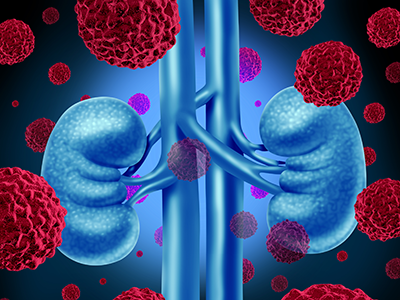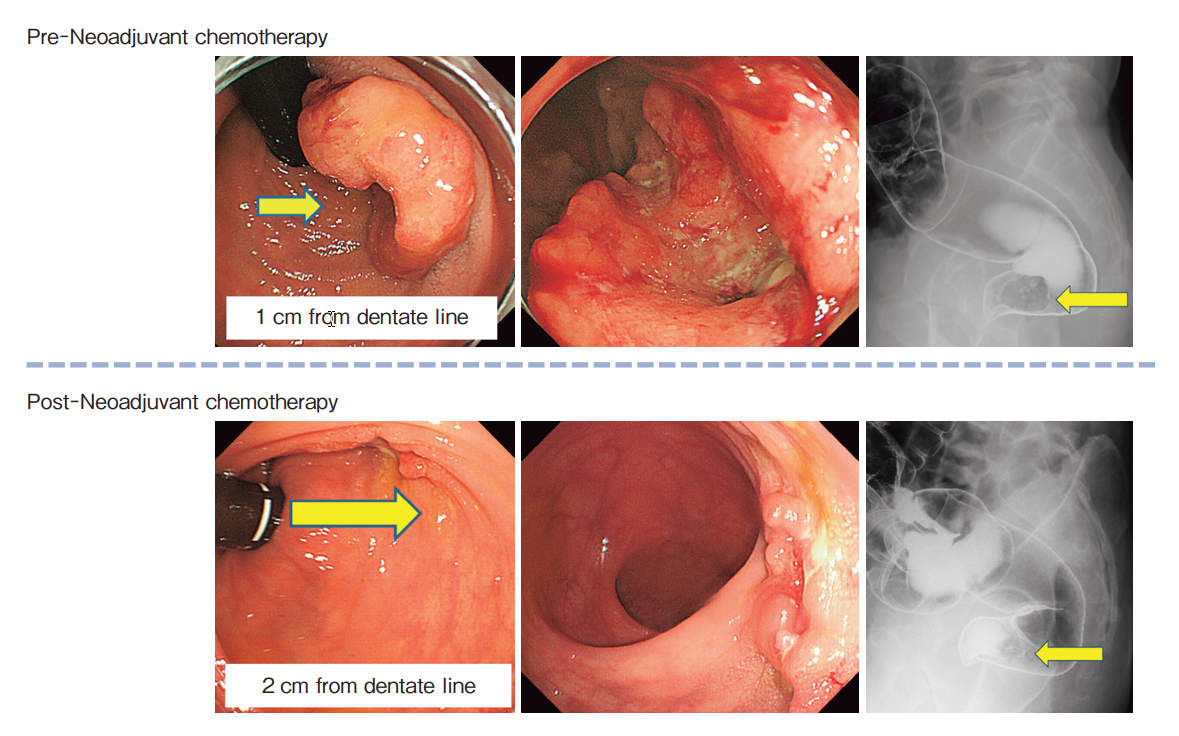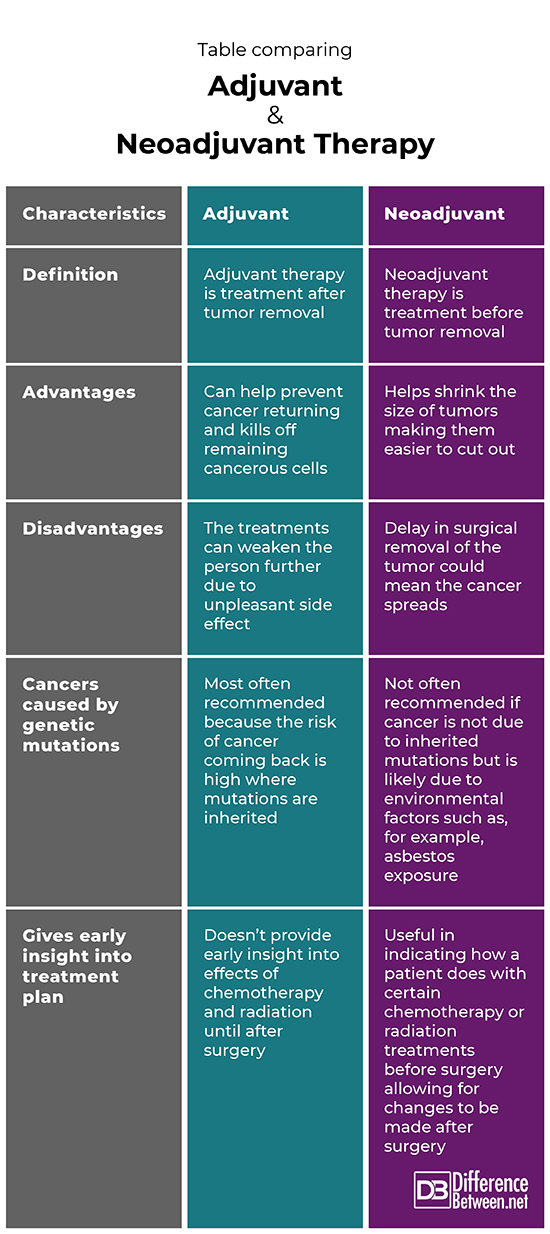Difference Between Adjuvant and Neoadjuvant Therapy
Adjuvant therapy is any treatment used after a cancerous tumor has been surgically removed. Neoadjuvant therapy is a treatment that is administered before a cancerous tumor is surgically removed.

What is Adjuvant therapy?
Definition:
Adjuvant therapy is any therapeutic method used after surgical resection of a cancerous tumor. This often includes radiation therapy or chemotherapy but can also include pain management.
What it is used for:
This type of therapy is used as a way to decrease the risk of cancer returning and sometimes to help improve the quality of life of terminally ill patients. Opioid pain killers can be given to treat pain in patients who reach a terminal state, even after a tumor has been surgically removed.
Advantages:
There are benefits for a patient to have adjuvant therapy. The most obvious advantage is that it can help stop cancer coming back and it can help to kill off any remaining cancerous cells in the body. It also helps to improve the quality of life and ease the pain and suffering of patients who are terminal.
Disadvantages:
The therapy can make the person feel weak and sick, particularly in the case of chemotherapy. Adjuvant therapy can sometimes result in long-term side effects; for example, in the case of some breast cancer patients, side effects such as fatigue, cognitive problems, and hot flashes became problematic and chronic.
Examples:
Adjuvant aromatase inhibitor therapy is used to treat women with certain forms of breast cancer. In addition, targeted therapy such as that used to block human epidermal growth factor receptor 2 (HER2) is often used as an adjuvant therapy in women with breast cancer. A chemotherapy drug is given as a pill or intravenously to treat colon cancer after surgery.

What is Neoadjuvant therapy?
Definition:
Neoadjuvant therapy is given before any surgery is done on a cancerous tumor, and may take the form of radiation therapy or chemotherapy.
What it is used for:
Generally, the idea behindneoadjuvant therapy is that it helps tumors to shrink and become easier to surgically extract. It can result in down-staging of the particular cancer, making it easier to treat; this was found to be the case in a study done on breast cancer patients.
Advantages:
Neoadjuvant therapy gives researchers an opportunity to study cancer cells in vivo. If the therapy is effective it can make a big difference because it can shrink previously unresectable tumors making them small enough to then surgically remove.
Disadvantages:
The main disadvantage of neoadjuvant therapy is the concern regarding delay in surgical resection, with the fear that the stage of cancer may change, making the situation worse. The chemotherapy and radiation used during the therapy may also result in the patient becoming too weak for later surgical removal of their tumor.
Examples:
Neoadjuvant chemoradiation has been used to help decrease the size of tumors in the case of pancreatic cancer. It is also found to be a good strategy for non-metastatic breast cancer in studies done on mice, with fewer metastases forming when neoadjuvant therapy was done versus when it was not.
Difference betweenAdjuvant and Neoadjuvant therapy?
Definition
Adjuvant therapy is any type of treatment done after tumor removal. Neoadjuvant therapy is treatment done before tumor removal
Advantages
Advantages of adjuvant therapy include the fact that it helps to prevent cancer returning and kills off any remaining cancer cells. Neoadjuvant therapy helps shrink the size of tumors making them easier to cut out in surgery.
Disadvantages
Adjuvant therapy has the disadvantage that the treatment can weaken the person further because of the side effects. Neoadjuvant therapy has the disadvantage that a delay in removing the tumor by surgery may cause the disease to spread.
Cancers caused by genetic mutations
Adjuvant therapy is most often recommended when cancers are due to inherited gene mutations. Neoadjuvant therapy is not recommended if the cancer is due to gene mutations.
Gives early insight into treatment plan
The adjuvant therapies do not give early insight into how a patient does with a particular form of chemotherapy or radiation therapy. The neoadjuvant therapies give early insight into how a patient does with certain chemotherapy or radiation treatments before surgery occurs, thus allowing for changes to be made after surgery.
Table comparing Adjuvant and Neoadjuvant therapy

Summary of Adjuvant and Neoadjuvant therapy
- Adjuvant and neoadjuvant therapy are both used in the treatment of certain types of cancer.
- Adjuvant therapy helps decrease the risk of cancer returning, and in cases of terminal diseases, helps with pain control.
- Neoadjuvant therapy makes surgery easier in some cases, although there is a slight risk the cancer spreads due to the delay in surgery.
- There are cases where both neoadjuvant and adjuvant therapies are used for patients.
- Difference Between Rumination and Regurgitation - June 13, 2024
- Difference Between Pyelectasis and Hydronephrosis - June 4, 2024
- Difference Between Cellulitis and Erysipelas - June 1, 2024
Search DifferenceBetween.net :
Leave a Response
References :
[0]Ikeda, Tadashi, et al. "The role of neoadjuvant chemotherapy for breast cancer treatment." Breast Cancer 9.1 (2002): 8.
[1]Jessup, John M., et al. "Neoadjuvant therapy for unresectable pancreatic adenocarcinoma." Archives of Surgery 128.5 (1993): 559-564.
[2]Lussier, David, Angela G. Huskey, and Russell K. Portenoy. "Adjuvant analgesics in cancer pain management." The oncologist 9.5 (2004): 571-591.
[3]Image credit: https://upload.wikimedia.org/wikipedia/commons/4/40/Pre_and_post_chemotherapy_colorectal_cancer.png
[4]Image credit: https://innovationdistrict.childrensnational.org/wp-content/uploads/2020/10/illustration-of-cancer-cells-attacking-kidneys.png
